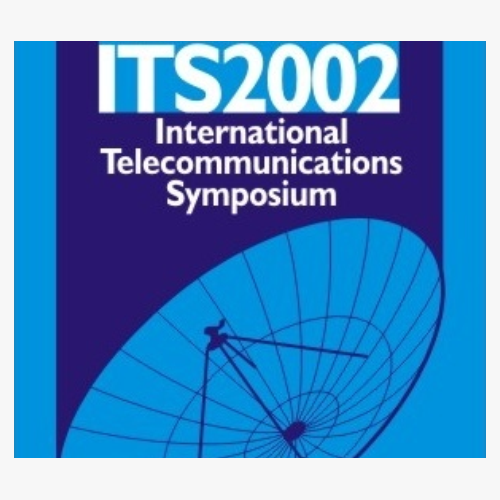
2002 International Telecommunications Symposium
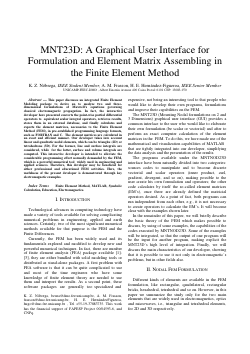
MNT23D: A Graphical User Interface for Formulation and Element Matrix Assembling in the Finite Element Method
K. Z. Nóbrega, A. M. Frasson, H. E. Hernández-Figueroa
DOI: 10.14209/its.2002.110
Keywords: Finite Element Method MATLAB Symbolic Calculation Education Electromagnetics
Abstract
"This paper discusses an integrated Finite Element Modeling package to derive an to analyze two and three-dimensional formulations of Maxwell’s equations governing classical electromagnetic propagation. In fact, the interactive developer here presented converts the point-wise partial differential operators to equivalent scalar integral operators, retrieves results, stores them in an external database, and finally calculates and exports the element matrices, necessaries to the Finite Element Method (FEM), in pre-established programming language formats, such as FORTRAN and C. The element matrices are calculated in an exact and efficient manner. Our developer takes into account linear and quadratic nodal elements, which can be triangles (2D) or tetrahedrons (3D). For the former, line and surface integrals are considered, while for the latter, surface and volume integrals are computed. This interactive developer is intended to alleviate the considerable programming effort normally demanded by the FEM, which is a powerful numerical tool widely used in engineering and applied sciences. Therefore, this developer may be beneficial for either professional and educational FEM activities. Here, the usefulness of the present developer is demonstrated through key electromagnetic examples."Download

An Efficient Algorithm for Radiowave Coverage Prediction in Urban Microcells
Daniela N. Schettino, Daniel H. D. Carvalho, Fernando J. S. Moreira
DOI: 10.14209/its.2002.116
Keywords: Radio channel characterization radiowave propagation uniform theory of diffraction ray tracing
Abstract
"This work presents an algorithm to perform radiowave coverage predictions in urban environments using the Uniform Theory of Diffraction (UTD). The ray-tracing algorithm is based on the image theory for a quasi-3D environment. Multiple reflections and diffractions are considered through the separation of multipath components into four different classes, used to determine the scattered field. The use of such classes eliminates redundant calculations throughout the ray-tracing process, improving the characterization of the power distribution over the coverage area."Download
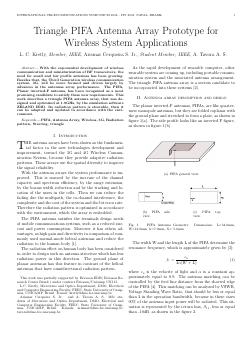
Triangle PIFA Antenna Array Prototype for Wireless System Applications
L. C. Kretly, Arismar Cerqueira S. Jr., A. Tavora A. S.
DOI: 10.14209/its.2002.122
Keywords: PIFA Antenna Array Wireless 3G Radiation pattern Steering triangle
Abstract
"With the exponential development of wireless communication and miniaturization of RF transceivers, the need for small and low profile antennas has been growing. Besides that, the Third Generation wireless communication system, 3G, will be more focused and driven largely by advances in the antennas array performance. The PIFA, Planar inverted-F antenna, has been recognized as a most promising candidate to satisfy these new requirements. This work describes a triangle PIFA antenna array, that was designed and optimized at 1.9GHz, by the simulation software ZELAND IE3D. Its radiation pattern is steerable, then it can be adapted and updated in accordance with the environment."Download
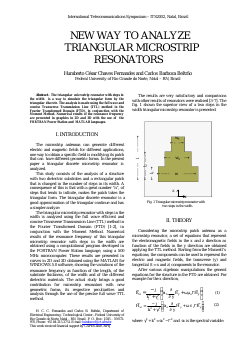
New Way to Analyze Triangular Microstrip Resonators
Humberto César Chaves Fernandes, Carlos Barboza Beltrão
DOI: 10.14209/its.2002.126
Keywords:
Abstract
"The triangular microstrip resonator with steps in the width is a way to simulate the triangular form by the triangular discrete. The analysis is made using the full wave and concise Transverse Transmission Line (TTL) method in the Fourier Transformed Domain (FTD), in conjunction with the Moment Method. Numerical results of the resonance frequency are presented in graphics in 2D and 3D with the use of the FORTRAN Power Station and MATLAB languages."Download
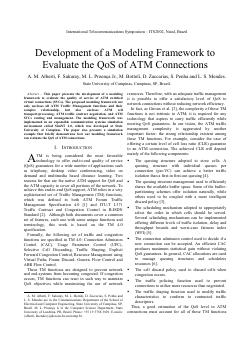
Development of a Modeling Framework to Evaluate the QoS of ATM Connections
A. M. Alberti, F. Sakuray, M. L. Proença Jr., M. Bottoli, D. Zaccarias, S. Penha, L. S. Mendes.
DOI: 10.14209/its.2002.129
Keywords:
Abstract
"This paper presents the development of a modeling framework to evaluate the quality of service of ATM switched virtual connections (SVCs). The proposed modeling framework not only encloses all ATM Traffic Management functions and their complex relationship, but also encloses ATM cell transport/processing, ATM traffic contract negotiation, and ATM SVCs routing and management. The modeling framework was implemented in an expansible communication systems simulation environment called SimNT 2.0, which was developed at State University of Campinas. The paper also presents a simulation example that briefly demonstrates how our modeling framework can evaluate the QoS of ATM connections."Download
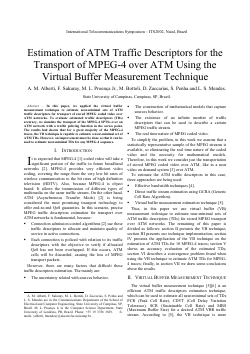
Estimation of ATM Traffic Descriptors for the Transport of MPEG-4 over ATM Using the Virtual Buffer Measurement Technique
A. M. Alberti, F. Sakuray, M. L. Proença Jr., M. Bottoli, D. Zaccarias, S. Penha, L. S. Mendes
DOI: 10.14209/its.2002.135
Keywords:
Abstract
"In this paper, we applied the virtual buffer measurement technique to estimate near-minimal sets of ATM traffic descriptors for transport of stored MPEG coded video over ATM networks. To evaluate estimated traffic descriptors (TDs) accuracy, we simulate the transport of the MPEG-4 SPTSs over an ATM network with a traffic policing function in the access point. The results had shown that for a great majority of the MPEG-4 traces, the VB technique is capable to estimate a near-minimal set of ATM TDs. However, an improvement must be done so that it can be used to estimate near-minimal TDs for any MPEG-4 sequence."Download
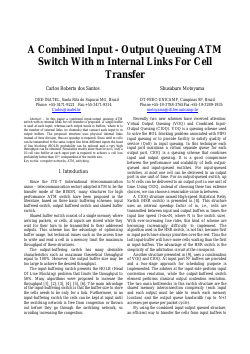
A Combined Input-Output Queuing ATM Switch with m Intenal Links for Cell Transfer
Carlos Roberto dos Santos, Shusaburo Motoyama
DOI: 10.14209/its.2002.141
Keywords: computer networks ATM switching
Abstract
"In this paper a combined input-output queuing ATM switch with m internal links for cell transfer is proposed. A single buffer is used at each input, whereas each output needs m buffers, where m is the number of internal links (or channels) that connect each input to m output buffers. The proposed structure uses physical internal links instead of time division, thus no speedup is required. Since until m cells can be transmitted to the same output line from different inputs the head of line blocking (HOLB) probability can be reduced and a very high throughput can be obtained. Simulation results show that for m=3, only a 10-cell size buffer at each input port is required to achieve a cell loss probability better than 10e-8, independent of the switch size. Key words: computer networks, ATM, switching."Download
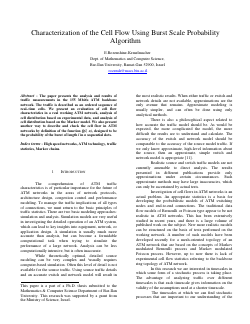
Characterization of the Cell Flow Using Burst Scale Probability Algorithm
E.Rozenshine-Kemelmacher
DOI: 10.14209/its.2002.146
Keywords: High speed networks ATM technology traffic statistics Markov chains
Abstract
"The paper presents the analysis and results of traffic measurements in the 155 Mbit/s ATM backbone network. The traffic is described as an ordered sequence of real\u2013time cells. We present an evaluation of cell flow characteristics in a real working ATM network, analysis of cell distribution based on experimental data, and analysis of cell distribution based on the Markov model. We also present another way to describe and check the cell flow in ATM networks by definition of the function Q(l, n), designed to be the probability of the burst of length l in n sequential slots."Download
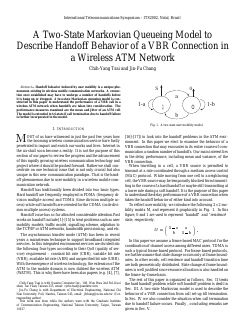
A Two-State Markovian Queueing Model to Describe Handoff Behavior of a VBR Connection in a Wireless ATM Network
Chih-Yang Tsai, Jin-Fu Chang
DOI: 10.14209/its.2002.150
Keywords:
Abstract
"Handoff behavior induced by user mobility is a unique phenomenon existing in wireless mobile communication networks. A connection once established may have to undergo a number of handoffs before it is hung up or dropped. A two-state Markovian queueing model is constructed in this paper to understand the performance of a VBR call in a wireless ATM network when handoffs are taken into consideration. The performance measures examined are the mean and jitter of an ATM cell. The model is extended to tri-state if call termination due to handoff failure is further incorporated in the model."Download
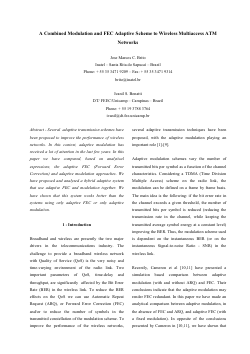
A Combined Modulation and FEC Adaptive Scheme to Wireless Multiaccess ATM Networks
Jose Marcos C. Brito, Ivanil S. Bonatti
DOI: 10.14209/its.2002.156
Keywords:
Abstract
"Several adaptive transmission schemes have been proposed to improve the performance of wireless networks. In this context, adaptive modulation has received a lot of attention in the last few years. In this paper we have compared, based on analytical expressions, the adaptive FEC (Forward Error Correction) and adaptive modulation approaches. We have proposed and analysed a hybrid adaptive system that use adaptive FEC and modulation together. We have shown that this system works better than the systems using only adaptive FEC or only adaptive modulation."Download